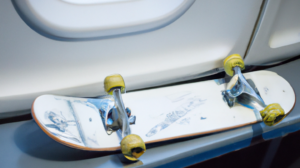Hang ten, but on land! If you’re a passionate surfer looking to bring the ocean vibes to the streets, look no further than surf skateboards. These unique boards combine the exhilaration of surfing with the freedom and versatility of skateboarding. Whether you’re new to the concept or already familiar with surf skateboards, this guide will provide all the information you need to transition smoothly and stylishly. So grab your board shorts, and let’s dive in!


What Are Surf Skateboards?
Let’s start by understanding what exactly surf skateboards are. Surf skateboards, also known as surf skates or surf trainers, are designed to replicate the feeling of riding a wave on land. They typically feature a more expansive deck, extensive and softer wheels, and a unique truck system that enhances maneuverability and responsiveness. These characteristics allow riders to simulate the fluid turns, carves, and pumping motions associated with surfing.
Why Transition with Surf Skateboards?
While each surfer may have their unique reason for transitioning with surf skateboards, here are a few benefits that make them an attractive option:
- Land-Surfing Experience: Surf skateboards allow surfers to practice and refine their skills even when they can’t make it to the ocean. It will enable them to maintain and improve their balance, footwork, and overall technique on land.
- Versatility: Unlike traditional skateboards, surf skateboards are designed to handle a wide range of terrain – from smooth pavement to rough concrete. This versatility allows riders to explore various spots and environments, creating endless possibilities for fun and adventure.
- Cross-Training: Surf skateboarding is an excellent form of cross-training for surfers. It helps build strength, increase endurance, and improve core stability, which are crucial for riding waves. By incorporating surf skateboarding into their routine, surfers can enhance their performance in the water.
Now that we understand the basics let’s delve deeper into the world of surf skateboards.
Choosing the Right Surf Skateboard
Regarding surf skateboards, finding the right board that suits your style and skill level is paramount. Here are a few factors to consider:
Deck Size and Shape
Surf skateboards come in various deck sizes and shapes. The size and shape of the deck will influence the board’s stability and maneuverability. Beginners may find more extensive panels more stable, while experienced riders might prefer smaller and narrower decks for increased maneuverability.
Truck System
The truck system of a surf skateboard is responsible for how the board pivots and turns. Choosing a truck system that matches your riding style and preferences is crucial. Some popular surfboard truck systems include Carver C7, Waterborne, and Yow.
Wheel Type and Size
The wheels of a surf skateboard play a key role in how the board rides and feels. Soft wheels provide better grip and control, making them ideal for carving and cruising. Larger wheels offer better stability and easily roll over cracks and pebbles, while smaller wheels are more responsive and agile for quick turns and maneuvers.
Fin Setup
Some surf skateboards come with removable fins that mimic the feeling of riding a surfboard. Fins add stability and control to the board, allowing riders to practice sharper turns and cutbacks. They can be adjusted or removed based on personal preference and the desired surfing experience.
Before making a purchase, consider trying out different boards to find the one that feels the most natural and comfortable. Experiment with different setups to discover what suits your style and helps you progress.
Transitioning Techniques
Transitioning from surfing to skateboarding requires adapting your technique to the unique characteristics of a surf skateboard. Here are a few tips to help you make a seamless transition:
Stance and Footwork
The first step is finding your stance. Most surfers prefer using their back foot as the guiding foot, similar to their surfing stance. However, some riders may find it more comfortable to adopt a regular or goofy stance, depending on their natural foot placement.
In terms of footwork, practice shifting your weight and engaging your core to execute smooth turns and pumping motions. Keep your knees slightly bent, and use your legs to generate power and maintain balance.
Carving and Pumping
Carving is an essential technique in surf skateboarding that mimics the fluid movements of surfing. It involves making controlled and sweeping turns by leaning into the board’s rail. Utilize your body and arms to initiate the turns and maintain a wide stance for stability.
Pumping refers to the motion of generating speed without pushing off the ground. It involves shifting your weight between the front and back foot while bending your knees and using your legs to compress and extend. Mastering the pumping technique allows you to maintain momentum and flow as you ride.
Drawing Inspiration from Surfing
As a surfer transitioning to skateboarding, you already possess knowledge and experience. Apply your surfing expertise to your skateboarding sessions. Imagine riding a wave as you practice your carves, cutbacks, and bottom turns. By channeling the feeling of surfing, you can enhance your skateboarding skills and bring a unique style to your ride.
Progression and Safety Tips
As with any board sport, progression, and safety go hand in hand. Here are some tips to help you progress efficiently while staying safe:
- Start with minor, gradual progressions and build your skills gradually. Take your time with the process, and always prioritize safety.
- Practice in open areas with minimal obstacles to avoid potential accidents.
- Wear appropriate protective gear such as a helmet, knee and elbow pads to protect yourself from injuries.
- Consider taking lessons or learning from experienced riders who can provide guidance and valuable tips.
- Be mindful of your surroundings and respect local laws and regulations when riding in public spaces.
- Don’t be afraid to challenge yourself and step out of your comfort zone. Push your limits, but always stay within your skill level to avoid unnecessary risks.
Conclusion
Surf skateboards offer an exciting opportunity for surfers to extend their passion beyond the waves. By transitioning to surf skateboarding, you can experience the thrill of surfing on land, develop new skills, and enhance your overall performance as a surfer. Remember to choose the right board, adapt your technique, and progress steadily while keeping safety in mind. So strap on your helmet, grab your board, and embark on a thrilling journey from the surf to the streets!







